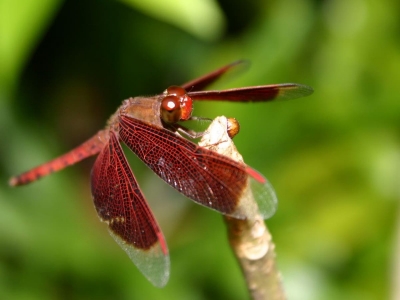
Dragonfly, (suborder Anisoptera), also called darner, devil’s arrow, or devil’s darning needle, any of a group of roughly 3,000 species of aerial predatory insects most commonly found near freshwater habitats throughout most of the world. Damselflies (suborder Zygoptera) are sometimes also called dragonflies in that both are odonates (order Odonata).
Young dragonflies, called larvae or sometimes nymphs or naiads, are aquatic and are as dedicated predators under water as the adults are in the air. The functionally wingless larvae are usually mottled or dull in colour, matching the sediments or water plants among which they live. They have bulging eyes somewhat similar to the adults, but possess a formidable anatomical structure not present in the adult. Called the “mask,” it is a fusion of the larva’s third pair of mouthparts. Disproportionately large, the mask folds beneath both the head and thorax when it is not in use. At the end of the mask is a set of fanglike pincers used to seize prey such as worms, crustaceans, tadpoles, and small fish. Different species of dragonfly larvae can be described as sprawlers, burrowers, hiders, or claspers. Their shape, metabolism, and respiration differ concordantly with the microhabitat they occupy.
Larvae crawl from eggs laid in or near water. Some species lay their eggs inside plant tissue, others attach their eggs to substrates at or above the water’s surface, and some may drop or wash their eggs from their abdomen onto water. Larvae absorb oxygen from the water using gills inside the rectum. The abdomen draws water in and pumps it out again through the anus. Water can be forcibly expelled in this way, resulting in jet propulsion as a means of escape. Solid waste is also expelled in this manner. As the larva grows, it molts, its future wings first becoming apparent about halfway through the larva’s development. These wing sheaths then enlarge rapidly with each successive molt. Eventually, the larva crawls out of the water (often at night) and molts one last time, emerging as an adult and leaving behind a cast skin (exuvia).
Many dragonfly families have descriptive common names associated with their scientific names. Examples include the hawkers (Aeshnidae), petaltails (Petaluridae), and clubtails (Gomphidae). Numerous other names related to neither taxonomy nor fact have traditionally been applied to dragonflies, such as horse stinger. Dragonflies have also been known as “snake doctors” in the American South, owing to the superstition that they nurse ill snakes back to health. The term devil’s darning needle is derived from a superstition that dragonflies may sew up the eyes, ears, or mouth of a sleeping child, especially one who has misbehaved. In reality, dragonflies present no danger to humans.
Credit : Britannica
Picture Credit : Google




